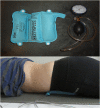Evaluation of Postural Stability and Transverse Abdominal Muscle Activity in Overweight Post-Stroke Patients: A Prospective, Observational Study
- PMID: 32110078
- PMCID: PMC7039244
- DOI: 10.2147/DMSO.S235015
Evaluation of Postural Stability and Transverse Abdominal Muscle Activity in Overweight Post-Stroke Patients: A Prospective, Observational Study
Abstract
Purpose: Post-stroke hemiparesis has a significant impact on postural stability. The transversus abdominis (TrA) muscle contributes to the stability of the spine. The aim was to assess both the postural stability and the activity of the TrA muscle in overweight post-stroke patients.
Methods: A group of 56 participants (61.12 ± 11.5 years) was divided into the study group (n=28 post-stroke patients, 63.7 ± 10.9 years) and control group (n= 23 healthy participants (58.5 ± 12.2 years). The Berg Balance Scale (BBS) and the Timed Up and Go Test (TUG) were used to evaluate postural stability and risk of falls. The Pressure Bio-Feedback Stabilizer (PBFS) device was used to assess functional stability.
Results: Stroke had a significantly negative effect on the BBS (p < 0.001) and TUG (p = 0.001). The older age negatively affected the BBS (p = 0.001), TUG (p = 0.017), and the TrA muscle activity (p = 0.017). Higher values of body mass index (BMI) negatively affected the BBS (p = 0.028), however there were no changes of TUG results (p = 0.141), and the TrA muscle activity (p = 0.808). Also, BBS and TUG results were not associated with TrA muscle activity (p = 0.541 and p = 0.411, respectively). The results of the BBS, TUG, and PBFS did not differ according to gender (p < 0.05). Time from stroke negatively affected the TUG (p = 0.001), but had no effect on the TrA muscle activity (p < 0.05). The side of hemiparesis did not affect the postural stability (p < 0.05).
Conclusion: The consequences of a stroke have an essential negative effect on postural stability. Factors such as age, gender, time from stroke, and the side of the hemiparesis have not negatively affected postural stability in overweight post-stroke patients.
Keywords: body mass index; muscle activity; post-stroke hemiparesis; postural control; postural stability; risk of falls; transversus abdominis muscle.
© 2020 Kołcz et al.
Conflict of interest statement
The authors declare no potential conflict of interest with respect to the research, authorship, or publication of this article.
Figures
References
-
- Pająk A, Szafraniec K, Janion M, et al. The impact of the Polish national Programme of Cardiovascular Disease Prevention on the quality of primary cardiovascular disease prevention in clinical practice. Kardiol Pol. 2010;68(12):1332–1340. - PubMed
-
- Gubitz G, Saini M, Belson S, Sahathevan R, Sandercock P, WSO Education Committee and WSO Educational Needs Workshop participants. How can the World Stroke Organization (WSO) optimize education in stroke medicine around the world? Report of the 2018 WSO Global Stroke Stakeholder Workshop. Int J Stroke. 2019;1747493019874726. doi:10.1177/1747493019874726 - DOI - PubMed
-
- Grabowska-Fudala B, Jaracz K, Górna K. Stroke incidence case fatality and mortality – current trends and future prognosis. Epidemiol Rev. 2010;64(3):439–442. - PubMed
LinkOut - more resources
Full Text Sources


